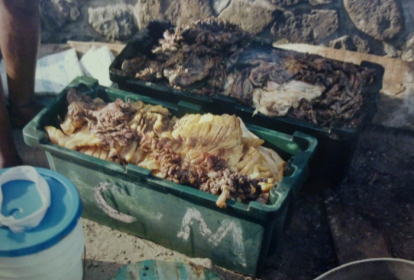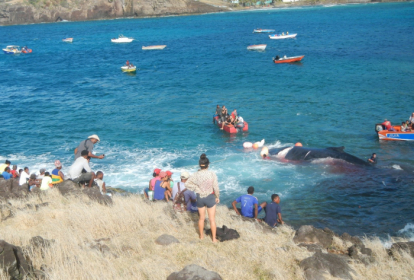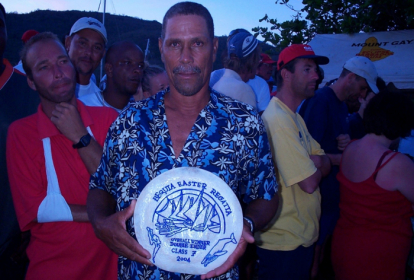1. Introduction: Information on the geographical location, history and present practices of the hunt

The Island, its people and its past
Bequia (Island of the Cloud), the largest of the St. Vincent Grenadines, which is located nine miles south of the main island of St. Vincent, has a population of just over 5,000 persons, and a land mass of seven square miles. The natives depend solely on tourism and the bounties of the sea for survival.
In 1876, just after the failure of agriculture for the export market, there was a growing need for a viable income, as well as additional protein in their diet, to supplement their corn, peas, and cassava diet. Thus whaling, patterned after the Yankees method, was introduced.
The same traditional methods of hunting, killing and processing of a humpback whale (as taught by the Yankees -our American predecessor) continue today. The same implements are used, and the methods of harvesting and processing the whale remain practically the same as in the 1870’s. The only distinction is that the once vibrant export market for St. Vincent and the Grenadines has fallen from 4th in GDP to zero, as regulated by the IWC.
 Whaleboat “Dart” stored at the Bequia Heritage Foundation Boat Museum
Whaleboat “Dart” stored at the Bequia Heritage Foundation Boat Museum
Quotas and Cultural Practices
Presently the whalers of Bequia carry out their historical, cultural activity under the IWC's regime, with the ASW quota of four whales per year since 2013. It follows a strict reporting mechanism. This quota was reached only once since it was introduced (2013), due largely to the weather conditions and the use of traditional open boats (the whale boats used are almost replicas of the original beetle boats - the Nancy Dawson and Iron Duke - brought from New Bedford in the 1860s). Hunting equipment (harpoons, lances, bombs, guns and other tools and implements) are identical to those used over 140 years ago.
In 2018, weather conditions were so severe, that the boats (two in the current fleet) were able to sail for the annual hunt for two days only. This caused serious setbacks to the community and whaling families who look forward to a boost in their protein diet.
 Traditional blessing of the boat
Traditional blessing of the boat
Whalers continue to practice their cultural tradition of ‘Blessing of the Boats’ before the start of the annual hunt, which is followed by a festive party that sets the mood for the hunt and prepares the men psychologically for the dangers of the hunt.
The whales, when harpooned, are wrestled near the boat, where they are lanced or bombed until they are dead. In modern times, they are assisted in this process by other whalers, who use their normal fishing boats (speed boats) to help kill the whale quickly, using the darting gun. This process helps the whalers to satisfy the “Time to Death” criteria, which averages 17 to 30 minutes, and makes the process a lot more humane than earlier years. Once the whale is dead, the whalers must risk life and limb to venture into the water, which can sometimes be infested with sharks, to sew up the mouth of the whale, so that water does not enter the stomach and cause it to sink and be lost. The modern use of scuba gear also reduces the loss of dead whales to zero.
 Harpooning the whale
Harpooning the whale
Small armadas of fishing boats with outboard motors assist with the towing of the whale and the whaleboat back to the flensing station at Semple Cay, where it is processed using traditional methods, and where the meat and blubber are shared using the same method introduced by the Yankee and Scottish whalers.
The owner gets a double portion for his share, as it is generally his responsibility to provide all the equipment and repair and maintain the boat. No financial assistance is provided, therefore some of the meat is sold to the villagers at a cost of East Caribbean $5.00 or approximately US $1.50 per lb., to help with the recovery of some costs. Following the stipulations of the IWC, the whalers do not sell any edible product outside of St. Vincent and the Grenadines.
 Sample Cay Whaling Station
Sample Cay Whaling Station
Processing of the whale
The processing of a whale attracts hundreds of visitors and island people to the “Whale Cay” to join the festivities, take photographs, or to obtain a portion of the meat which is highly prized in the community and treated as a special treasure.
 Crowds converge on the dead whale to get a portion of the meat
Crowds converge on the dead whale to get a portion of the meat
It takes about two days for an adult whale to be completely processed, and to clean up afterwards. The ropes must be dried, harpoons straightened and sharpened, and preparation begins for the next hunt or the storage of the boats until the next season.
Whale meat which traditionally was eaten in one of two ways - deep fried (doved) in its own oil, or salted and dried in the sun (corned), and boiled with potatoes - is now eaten in every conceivable manner, or stored in refrigerators for very special occasions. The bones are dried and processed into souvenirs and other handicraft, and sometimes used as handrails and banisters in homes, as well as decorative pieces in restaurants and bars. While these bones present an opportunity for our skilled artisans to design and build souvenirs, jewellery and trophies, the imposition of the CITES treaty limits who will buy these gifts on the local craft markets.
 Barbequed whale
Barbequed whale
The entire process from the launching of the boats to the hauling, cutting and sharing of the whale must be done manually, as there is no machinery or electricity on the “whale cay”.
2017 however proved to be an exceptional year. An adult humpback of 50 feet, was caught and processed in record time. It had been rumoured by the anti-whaling groups who infiltrate our community that 2017 was the last year for the hunting of whales. This practically triggered a stampede as, what appeared to be, the whole community converged on the whale cay, and there was a mad rush by each person to gather and cut a piece of the “last whale” for themselves. The entire animal was processed in approximately 5 hours.
Importance of Subsistence Whaling for Food Security
Such frenzied activity as described above helps to cement the need for improved food security.
This rich source of protein allowed the community to supplement its diet. Largely because of the tight family structure and its tradition of sharing resources, hundreds of dollars in foreign exchange were saved, which would otherwise have gone to import meat products.
The size and type of boats currently being used by our fisher folk, and the scant export market for fish and fish products, are exacerbated by the limited processing of fish or fish products on the island. This increases the demand for whale meat as a stable food supplement. Adverse weather conditions which are demonstrated through the increase frequency of storms and tropical depressions, and recently (since 2011) the inundation of our beaches and coastal regions by Sargassum weed which kills all near-shore life and entangles the fisherfolk’s nets, traps, and lines, create more hardship. These impact on the livelihoods of our marine-based economy and security.
The preservation and protection of the species is of significant value to the people of Bequia who recognise the importance of the humpback whale to their food security, and the preservation of their historical, cultural and religious observances and rights.
2. International Whaling Commission
Based on the findings of the recently concluded meeting of the IWC Scientific Committee, and the reports of the abundance of the stock, the whaling community would very much like to have a renewed quota of four whales per season. This is justifiable in the circumstances.



